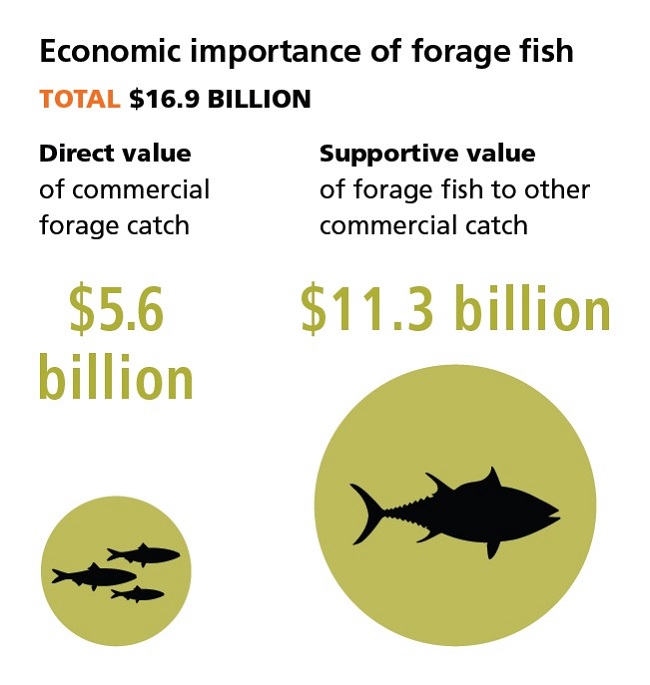The Economic Value of Forage Fish
From Little Fish, Big Impact, a report from the Lenfest Forage Fish Task Force
On April 3, 2012, the Lenfest Forage Fish Task Force released Little Fish, Big Impact, the most comprehensive global analysis to date of the biology and management of forage fish. One of its significant contributions is the first global estimate of the total economic value of forage fish to commercial fisheries, including their indirect, “supportive” value when left in the ocean.
The Task Force used 56 food web models from the scientific literature to estimate (1) the volume of forage fish catch and (2) the contribution of forage fish as prey to the catch of other commercial fish, such as tuna, salmon, and cod. By combining these results with a database of fish prices, the Task Force calculated both “direct value” from catch of forage fish and “supportive value”—their value when left in the water as food for commercially fished predators. The Task Force found that:
- Globally, forage fish are twice as valuable in the water as in the net.
The report estimates that the supportive value of forage fish left in the water as food for commercially valuable predators is $11.3 billion globally (in 2006 dollars), compared to a direct catch value of $5.6 billion. Supportive value is greater than direct value in 30 of the 56 ecosystem models studied.
- Forage fish direct and supportive values vary tremendously across the globe.
The Task Force found some patterns across latitudes and ecosystem types. For example, the direct value of forage fish is greatest on average near the equator and lowest at high latitudes. The reverse is true for supportive value, which is greatest at high latitudes and lowest near the equator, on average. (The Task Force did not investigate possible explanations for these trends.) - Managers can identify trade-offs.
The Task Force’s analysis provides a method for identifying the economic value of forage fish, both as a commodity and as prey for other commercial fisheries. Managers may use or expand upon this approach in specific ecosystems to examine potential trade-offs between harvesting forage fish and keeping them in the ocean. - Management should focus on predators.
Because forage fish tend to be more valuable as prey than as direct catch, the Task Force recommends that managers focus on the needs of predators when making decisions about forage fisheries. In addition to its economic analysis, the Task Force analyzed strategies to help ensure forage fishing does not unduly deplete predator populations. Based on this analysis, the Task Force recommends cutting catch rates by at least half in most ecosystems and doubling the minimum population size of forage fish, relative to conventional management.



